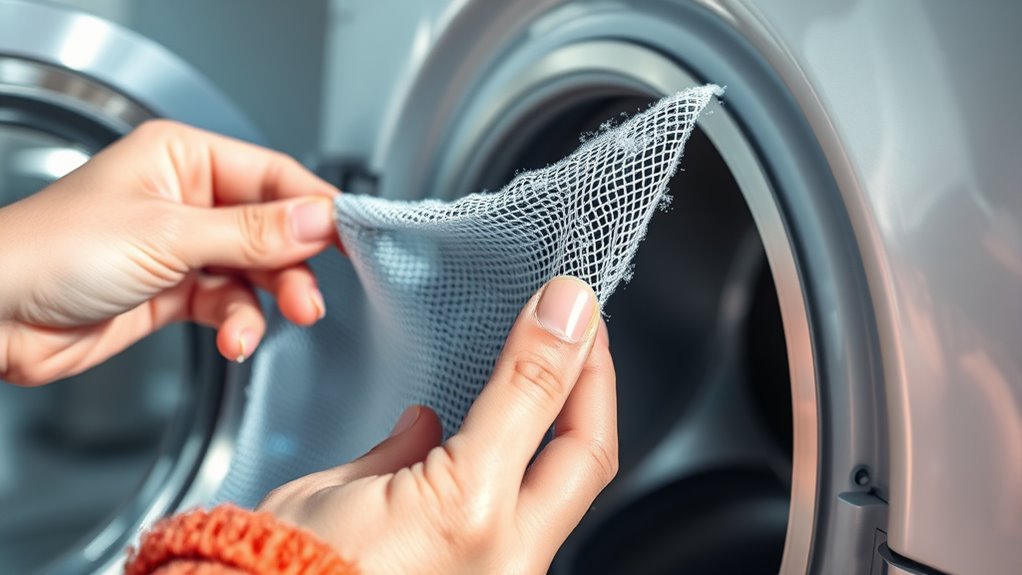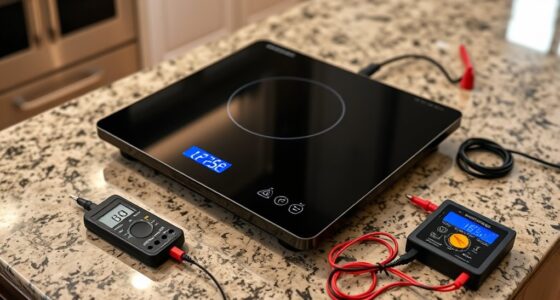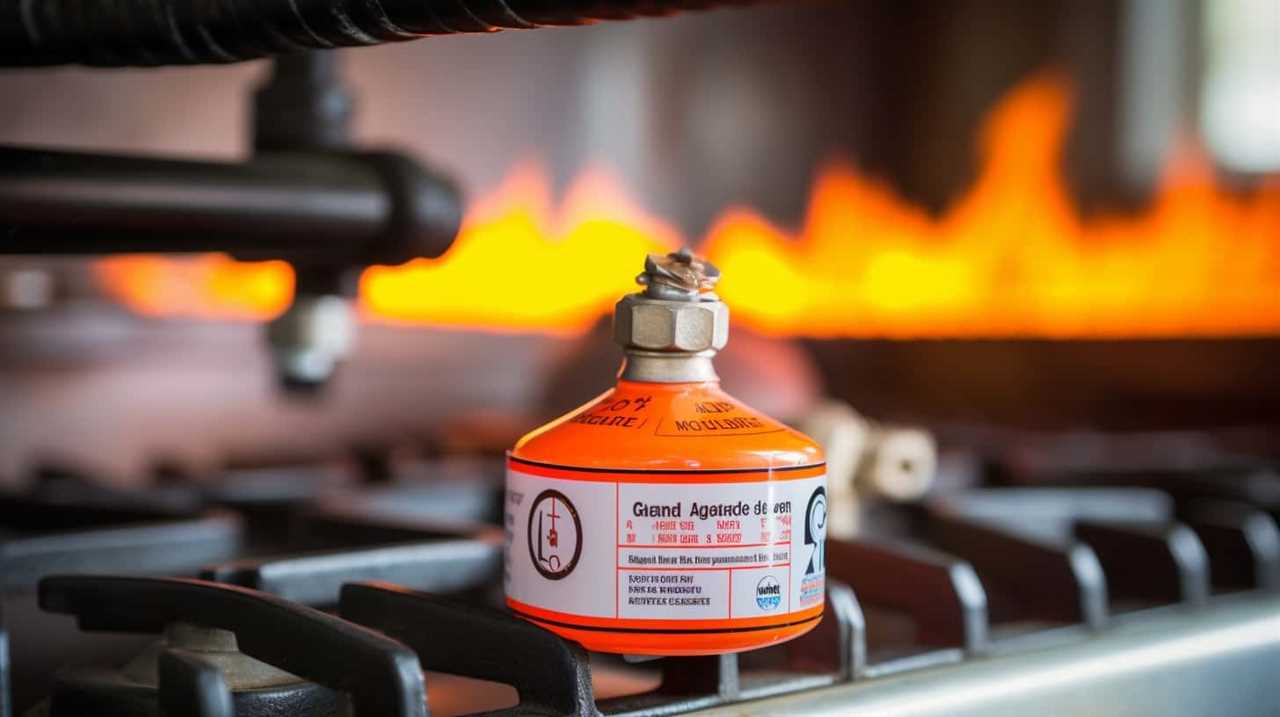To keep your condenser dryer running efficiently, regularly clean the lint screen after every load using a soft brush or vacuum to remove lint buildup. Always unplug the dryer before maintenance, carefully remove the lint screen, inspect it for damage, and wash it with warm water if needed. Don’t forget to also clean the lint trap cavity and reinsert the screen securely. Following these best practices guarantees safety and long-lasting performance—learn more about proper cleaning steps and routines to optimize your dryer’s efficiency.
Key Takeaways
- Regularly remove and inspect the lint screen for tears, holes, and buildup to ensure optimal airflow and safety.
- Use a soft brush, vacuum, and warm water to thoroughly clean the lint screen and cavity, avoiding harsh tools.
- Unplug the dryer before cleaning, wait for residual power to drain, and wear gloves for safety.
- Reinstall the lint screen securely after cleaning to prevent airflow blockages and maintain efficiency.
- Establish a routine: clean lint screen after each load and perform deep cleans weekly or monthly for best results.
Understanding the Importance of Regular Lint Screen Cleaning
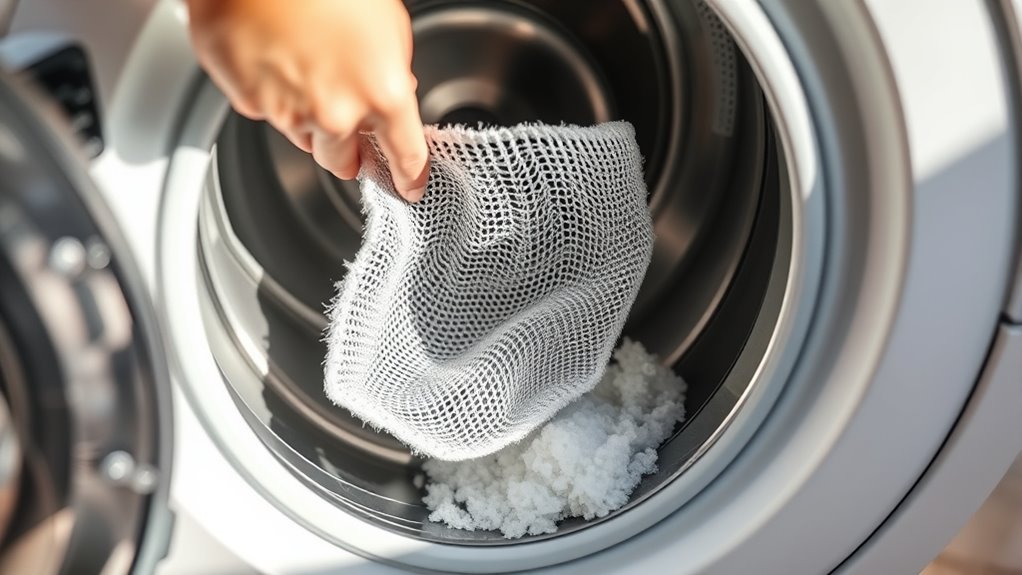
Regularly cleaning the lint screen is essential because it guarantees your condenser dryer operates efficiently and safely. When you clear lint buildup, you prevent airflow blockages that can cause longer drying times and higher energy consumption. A clogged lint screen forces the dryer to work harder, increasing wear and tear on components and raising the risk of overheating. This not only wastes electricity but also poses a fire hazard. Keeping the lint screen clean ensures proper airflow, which helps the dryer dry clothes faster and reduces energy bills. Additionally, it prolongs the lifespan of your appliance by preventing unnecessary strain on the dryer components. Regular maintenance also reduces the likelihood of malfunctions caused by internal obstructions, improving overall safety, as well as maintaining optimal airflow and performance. Incorporating routine lint screen cleaning can also extend the life of other dryer parts by preventing dust and debris buildup. Making lint screen cleaning a regular habit is a simple yet effective way to maintain peak dryer performance and ensure your safety. Regularly inspecting and cleaning the lint screen helps prevent lint accumulation, which can significantly impact the dryer’s efficiency and safety.
Gathering the Necessary Tools and Supplies

Before you start cleaning, you’ll want to gather all the tools and supplies you’ll need. Make sure you have the essential tools on hand and a checklist of cleaning supplies to keep everything organized. Having everything ready will make the process quicker and more efficient. Additionally, consider reviewing air purifier maintenance dos and don’ts to ensure proper handling during cleaning. If you’re also interested in grocery savings strategies, applying some of these organizational tips can help you keep track of your cleaning supplies and maintenance schedules more effectively. For optimal results, understanding the self watering plant pots system can help you identify specific parts that may require cleaning or replacement during maintenance. Incorporating regular maintenance routines can further extend the lifespan of your appliances and ensure optimal performance. Similarly, using dedicated cleaning tools designed for lint screens can improve the effectiveness of your cleaning process.
Essential Tools Needed
To effectively clean your condenser dryer’s lint screen, you’ll need to gather a few essential tools and supplies. First, have a soft brush or old toothbrush to loosen stubborn lint and debris. A microfiber cloth or damp rag will help wipe down the screen and surrounding areas. You should also have a small screwdriver if your lint screen cover requires removal, and a vacuum cleaner with a hose attachment to remove accumulated lint inside the dryer. Additionally, keep a container or tray nearby to catch any loose lint or debris that may fall during cleaning. These tools ensure you can thoroughly and safely clean the lint screen, preventing build-up and maintaining dryer efficiency. Incorporating automated cleaning systems can further enhance the process and reduce manual effort. Automation technologies are increasingly used in appliance maintenance to improve efficiency and reliability. Incorporating advanced cleaning tools can further streamline the process and ensure a more thorough job. Having everything ready before you start makes the process smoother and more effective, especially when combined with proper maintenance techniques.
Cleaning Supplies Checklist
Gathering the right cleaning supplies guarantees you can efficiently clean your condenser dryer’s lint screen without interruptions. Start with a soft brush or a vacuum attachment to remove loose lint. Keep a mild detergent or cleaning solution on hand to wipe down the lint screen if needed. You’ll also want a microfiber cloth or soft sponge for gentle cleaning. Have a small screwdriver ready if you need to remove the lint screen from the dryer. Additionally, consider using gloves to protect your hands and a container or towel to catch any debris. Ensuring these supplies are nearby saves time and prevents you from searching mid-cleaning. Being aware of essential oils for maintenance can also help in keeping your dryer smelling fresh and functioning optimally. Using proper cleaning techniques can extend the lifespan of your appliance and improve its efficiency. Regularly inspecting and maintaining the lint screen is essential for preventing fire hazards, as lint buildup is a common cause of dryer fires. Staying informed about fire safety precautions can further enhance your home safety. With everything prepared, you’ll be able to complete the task quickly and thoroughly, keeping your dryer running efficiently.
Safely Unplugging and Preparing Your Dryer
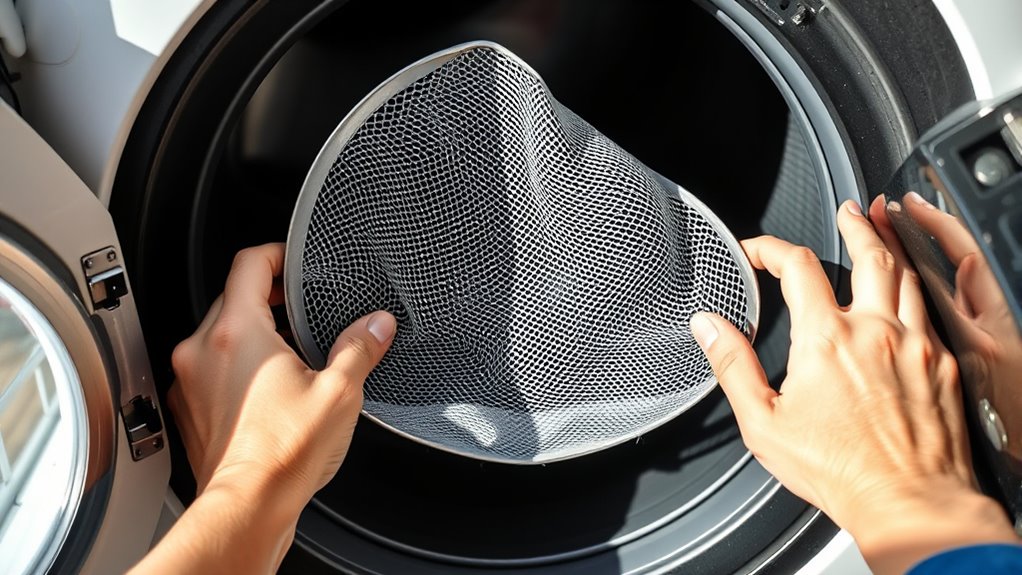
Before you start cleaning, make sure to unplug your dryer to avoid any electrical hazards. Clear the surrounding area so you have enough space to work safely. Taking these steps helps guarantee your safety and makes the process smoother.
Power Down Safely
Ensuring your dryer is powered down properly is essential for safe and effective lint screen cleaning. First, unplug the dryer from the electrical outlet to prevent any accidental activation. Wait a few minutes to let any residual power drain, especially if your model has a digital display. Confirm the power is off by gently tugging the cord or testing the outlet with a device.
| Step | Action | Safety Tip |
|---|---|---|
| Unplug the Dryer | Remove the plug from the wall socket. | Use both hands for stability. |
| Confirm Power Off | Check the outlet for current. | Use a tester if unsure. |
| Wait for Residual Power | Allow a few minutes before opening dryer. | Prevents electrical shock. |
Prepare Workspace Properly
To safely prepare your workspace, start by unplugging the dryer from the electrical outlet to eliminate any risk of electric shock. Once unplugged, move the dryer away from the wall to access the back panel easily. Clear the surrounding area of clutter to create a safe, organized space for cleaning. Gather necessary tools, like screwdrivers and a soft brush, so you’re ready to remove the lint screen and access internal components. Wearing gloves can protect your hands from sharp edges or dust. Make certain the room is well-lit to see all parts clearly. Taking these steps minimizes hazards and makes the cleaning process smoother, helping you maintain your dryer safely and effectively.
Removing the Lint Screen Correctly
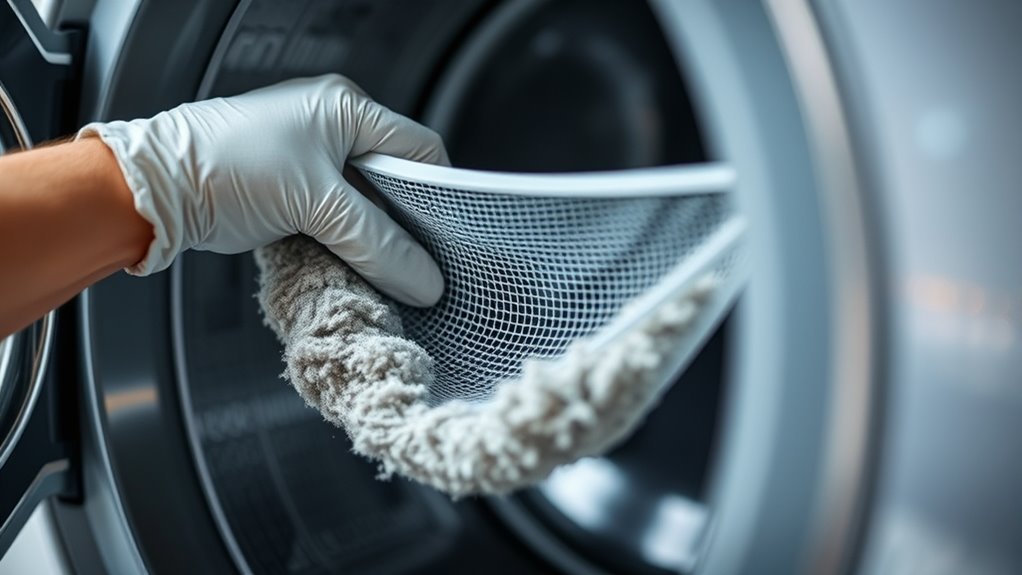
Removing the lint screen correctly is essential for maintaining your dryer’s efficiency and safety. Start by opening the dryer door and locating the lint screen, usually near the door frame or on top of the dryer. Gently pull the screen out, avoiding force or sudden tugs that could damage it. Use your fingers or a soft brush to eliminate any lint buildup on both sides of the screen. Be careful not to bend or break the screen frame. Once cleaned, insert the screen back into its slot firmly, ensuring it’s seated properly. Proper removal and reinsertion prevent damage and ensure the lint can be effectively collected during each drying cycle. Taking care during this process keeps your dryer functioning smoothly and reduces fire hazards.
Inspecting the Lint Screen for Damage or Wear

Take a close look at your lint screen for any tears or holes that could guarantee its effectiveness. Check for blockages or buildup that might prevent proper airflow. Addressing these issues ensures your dryer runs efficiently and safely.
Check for Tears
Inspecting your lint screen for tears or damage is a crucial step in maintaining your condenser dryer’s efficiency and safety. Carefully examine the entire surface for any rips, holes, or frayed edges. Even small tears can allow lint to escape, reducing drying performance and increasing fire risk. If you notice any damage, it’s best to replace the lint screen promptly to prevent lint buildup inside the dryer or potential hazards. While inspecting, check that the edges are intact and that the screen fits securely in its slot. Damaged screens can also cause uneven airflow, which affects drying times. Regularly inspecting for tears helps ensure your dryer operates safely and efficiently, saving you time and potential costly repairs down the line.
Examine for Blockages
Since blockages can reduce airflow and hinder drying efficiency, it’s important to examine your lint screen for any signs of buildup or obstruction. Look closely at the mesh for accumulated lint, dirt, or debris that might be clogging the openings. Use your fingers or a soft brush to gently remove loose lint, ensuring the screen is clear. Check for any signs of damage, such as warping, holes, or tears, which can compromise its effectiveness. If the screen is damaged, replace it to maintain proper airflow and prevent lint from escaping into the dryer. Regular inspection helps keep your dryer running smoothly and prevents long-term issues caused by airflow restrictions. Stay vigilant and clean or replace the lint screen as needed.
Cleaning the Lint Screen Using Proper Techniques
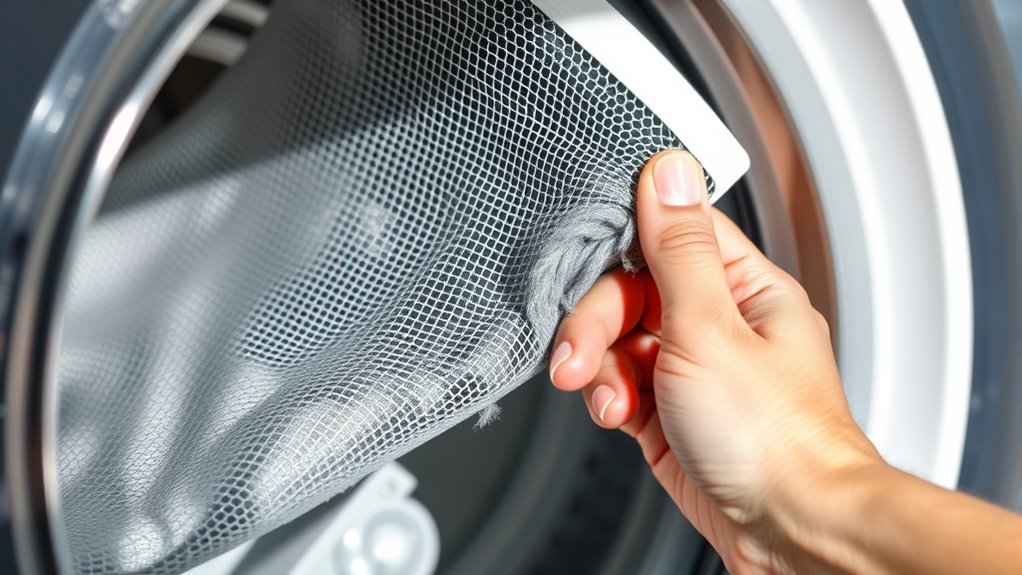
To guarantee your condenser dryer’s peak performance, it’s vital to clean the lint screen using proper techniques. First, turn off the dryer and open the door. Gently remove the lint screen, avoiding any force that could damage it. Use your fingertips or a soft brush to loosen and scrape off lint buildup; avoid using sharp tools that could tear the screen. Rinse the screen under warm water to remove residual lint and dust, then gently scrub with a soft brush or cloth if needed. Make sure to dry the screen thoroughly before reinserting it. Proper cleaning ensures maximum airflow, reduces drying time, and prevents potential damage. Regular maintenance like this keeps your dryer running efficiently and prolongs its lifespan.
Removing and Cleaning the Lint Trap Cavity
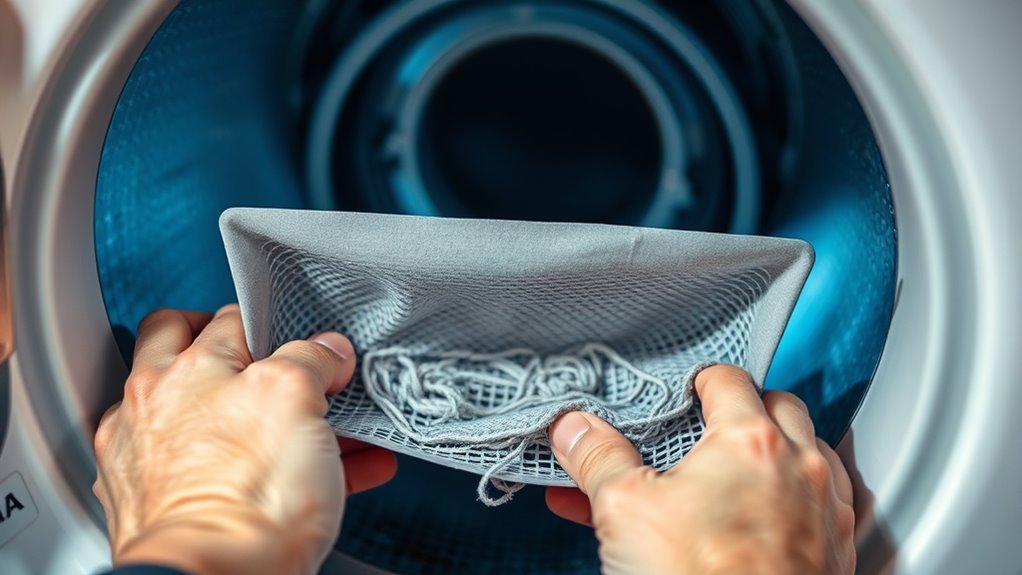
Before reinstalling the lint screen, it’s important to remove and clean the entire lint trap cavity to guarantee ideal airflow. Start by unplugging your dryer for safety. Remove the lint trap cover and carefully take out the lint trap assembly. Use a damp cloth or vacuum to clear lint buildup from the cavity walls and surrounding areas. This step prevents blockages that reduce drying efficiency.
To ensure thorough cleaning, consider these steps:
- Use a brush or vacuum attachment to remove stubborn lint from corners and crevices.
- Wipe down the entire cavity with a damp cloth to eliminate dust and debris.
- Allow the cavity to dry completely before reinserting the lint screen to prevent mold growth.
Reinstalling the Lint Screen Properly
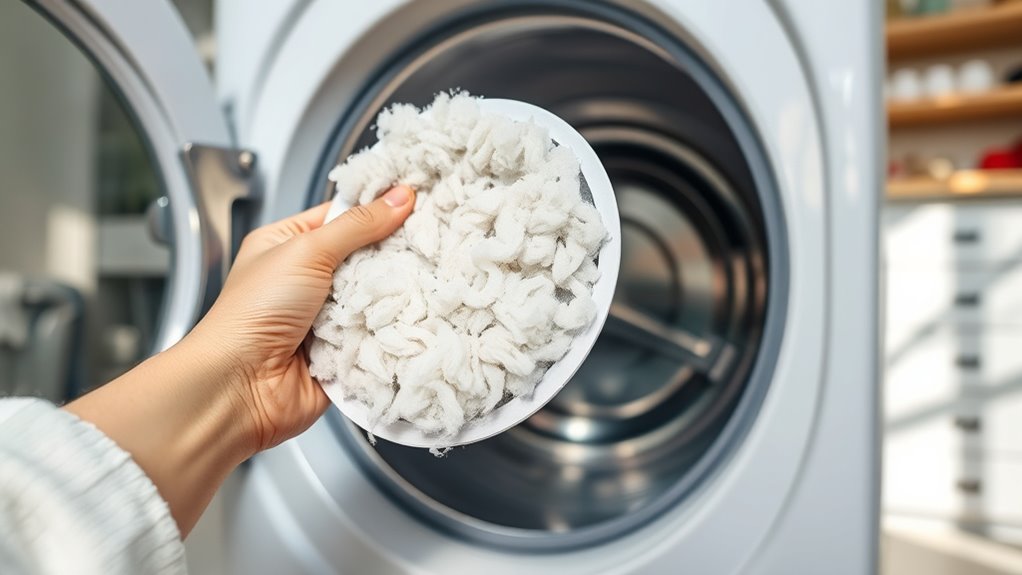
After cleaning the lint trap cavity, carefully reinsert the lint screen into its housing. Ensure the screen sits flush and is aligned correctly with the slots or guides. Check that it’s fully seated; a loose lint screen can cause lint to bypass the trap, reducing efficiency and increasing fire risk. If your dryer has a latch or clip, make sure it clicks into place securely. Avoid forcing the screen in if it doesn’t slide smoothly—recheck alignment first. Proper installation guarantees maximum airflow and prevents lint buildup in the dryer’s internal components. Before closing the dryer door, double-check that the lint screen is firmly in position. This simple step helps maintain your dryer’s performance and safety, saving you time and potential repair costs down the line.
Establishing a Routine Cleaning Schedule
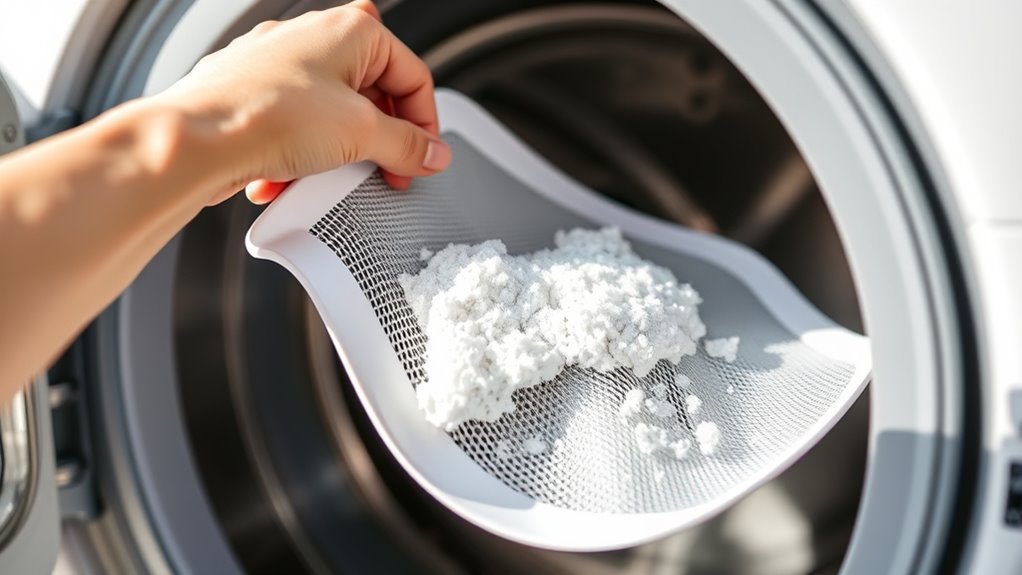
Establishing a routine cleaning schedule for your condenser dryer’s lint screen is essential for maintaining its efficiency and safety. Regularly cleaning the lint screen prevents buildup that can restrict airflow and cause overheating. To keep your dryer running smoothly, consider these steps:
- Clean after every load: Remove lint immediately after each use to prevent accumulation.
- Inspect weekly: Check the lint screen for tears or damage and replace if necessary.
- Deep clean monthly: Wash the lint screen with warm, soapy water to remove residue and lint stuck in the mesh.
Tips for Maintaining Overall Dryer Efficiency
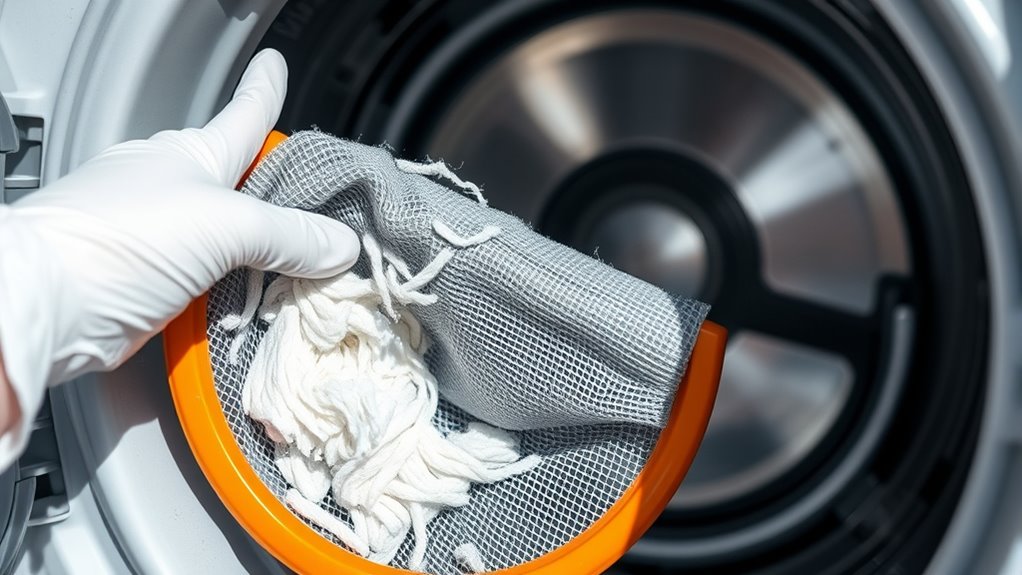
To keep your dryer running efficiently, it’s important to pay attention to more than just the lint screen. Regularly check and clean the condenser and vent ducts to prevent blockages that can cause longer drying times and increase energy consumption. Avoid overloading the dryer, which strains the motor and reduces airflow, leading to inefficient drying. Use the appropriate heat settings for different fabrics to prevent unnecessary energy use and fabric damage. Make certain the door seal is clean and intact to maintain proper temperature and airflow. Additionally, keep the area around the dryer clear of clutter to promote proper ventilation. Performing these simple maintenance tasks helps your dryer operate at peak efficiency, saves energy, and extends its lifespan.
Frequently Asked Questions
Can I Use Any Cleaning Agents on the Lint Screen?
You might wonder if any cleaning agents work on your lint screen. It’s best to avoid harsh chemicals or abrasive cleaners because they can damage the screen or reduce its effectiveness. Instead, use warm water and a soft brush or cloth to gently remove lint buildup. For stubborn residue, a mild detergent can help. Always guarantee the screen is completely dry before reinstalling it for safe, efficient dryer operation.
How Often Should I Replace My Lint Screen?
They say, “A stitch in time saves nine,” so it’s wise to substitute your lint screen regularly. You should change it every 6 to 12 months, depending on usage. If you notice it’s damaged, cracked, or heavily stained, swap it out sooner. Regularly replacing your lint screen ensures your dryer runs efficiently, prevents fires, and extends its lifespan. Don’t wait until it’s too late—stay proactive!
Are There Signs Indicating My Dryer Needs Professional Repair?
If your dryer isn’t working properly, look for signs like longer drying times, strange noises, or a burning smell. You might also notice that clothes don’t fully dry or the dryer frequently stops mid-cycle. If these issues persist even after cleaning the lint screen and checking vents, it’s time to call a professional. Ignoring these signs can lead to more costly repairs or safety hazards.
Does Cleaning the Lint Screen Affect Drying Times?
Cleaning the lint screen definitely impacts your dryer’s performance and drying times. When you remove lint buildup, airflow improves, allowing your dryer to operate more efficiently. This means clothes dry faster and more evenly. Regularly cleaning the lint screen prevents overheating and reduces energy consumption. So, by maintaining a clean lint screen, you help your dryer run smoothly, save time, and extend its lifespan.
Can Improper Lint Screen Cleaning Damage My Dryer?
You might wonder if cleaning the lint screen improperly can harm your dryer. If you use harsh brushes or scrape too aggressively, you could damage the screen or its housing, leading to malfunctions. Always follow the manufacturer’s instructions, gently remove lint, and avoid forcing the screen. Proper cleaning keeps your dryer running efficiently and prevents potential damage, ensuring your appliance stays in good shape for years to come.
Conclusion
Regularly cleaning your condenser dryer’s lint screen might seem like a hassle, but it’s essential for safe, efficient operation. Skipping this step can lead to longer drying times and potential fire hazards. If you think it’s too time-consuming, remember—spending a few minutes now saves you from costly repairs later. Make lint screen cleaning part of your routine, and enjoy faster, safer drying every time without the worry of unexpected issues.
